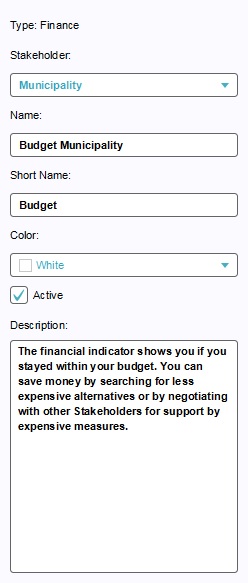Budget (Indicator): Difference between revisions
No edit summary |
|||
| Line 24: | Line 24: | ||
* [[Density indicators]] | * [[Density indicators]] | ||
* [[Green (Indicator)]]* [[Heat (Indicator)]]* [[Heat Reduction (Indicator)]]* [[Housing target (Indicator)]]* [[Parking (Indicator)]]* [[ Livability (Indicator)]]* [[Traffic Noise (Indicator)]] | * [[Green (Indicator)]]* [[Heat (Indicator)]]* [[Heat Reduction (Indicator)]]* [[Housing target (Indicator)]]* [[Parking (Indicator)]]* [[ Livability (Indicator)]]* [[Traffic Noise (Indicator)]] | ||
}} | |||
Revision as of 17:06, 25 January 2023
The budget indicator displays the amount of money a stakeholder has available. The budget is influenced by virtually all actions taken by a stakeholder. For example, placing a construction in the world will lower the budget of a stakeholder. Some constructions also provide money to the stakeholder, increasing their budget.
Each stakeholder has a budget, but the budget is only visible to the user when that stakeholder also has a budget indicator. Actions performed are still limited by the amount of money the stakeholder has available, even if the stakeholder does not have a budget indicator. If the stakeholder has a negative budget, they will receive a total score of zero, until the budget is at or above zero of the respective currency.
Indicator targets
The budget indicator has 1 value for a target.
- Amount of money that the Stakeholder needs to earn.
- In thousands, the amount of money that the stakeholder should have left to have this indicator at 100%. If the stakeholder has between 0 currency and the target amount, the score will lie between 0% and 100%. If the stakeholder has a negative budget, the indicator will have a negative percentage.
Indicator properties
This indicator is a stakeholder-specific indicator. This means the indicator is unique to a specific stakeholder. If multiple stakeholders have this indicator, they each have their own separate version, and their targets may differ.
This indicator is represented numerically, rather then with a progress bar.
This indicator functions by tally. The amount added and subtracted results in the current value.
This indicator scores uniformly on the entire session. It is not divided into a separate sub-score per zone.
